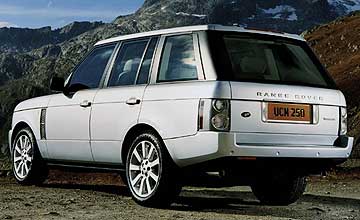BY MARTON PETTENDY | 5th Aug 2005

It now features two Jaguar-derived AJ (Advanced Jaguar) V8 petrol engines instead of the previous BMW V8.
A normally aspirated 4.4-litre (4394cc) engine produces 225kW of power at 5750rpm and 440Nm of torque at 4000rpm.
Above this is a slightly smaller 4.2-litre (4197cc) supercharged version rated at 291kW at 5750rpm and 560Nm at 3500rpm.
The smaller capacity was deemed necessary for optimum engine strength and durability as a result of the supercharging.
In contrast the outgoing and completely unrelated 4.4-litre (4398cc) BMW V8 pumped out 210kW at 5400rpm and 440Nm at 3600rpm.
Ford-owned Land Rover has decided that the German V8s are too expensive to continue sourcing from BMW.
Both AJ-V8s are mated to ZF's six-speed automatic gearbox with a Sport mode and sequential-shift operation, in lieu of the previous five-speed automatic unit.
Filled with fluid for life (or 240,000km) this transmission is 12 per cent lighter and has 30 per cent less moving parts than before.
The 4.4 hits the 0-100km/h mark in 8.7 seconds on its way to a 200km/h top speed, while the supercharged 4.2 slashes the former by 1.2 seconds while adding 10km/h to the latter.
The EU combined fuel use figure is 14.9 and 16.0l/100km respectively.
Meanwhile the BMW-sourced 130kW/390Nm 3.0-litre in-line six-cylinder engine in the otherwise-facelifted Td6 model remains unchanged, and is still offered with a five-speed automatic.
Land Rover will not use the smaller Range Rover Sport's Jaguar-sourced 2.7-litre turbo-diesel V6.
Instead a 3.6-litre turbo-diesel V8 engine - to be built by Ford in the UK - is expected to usurp the BMW Td6 engine sometime during next year.
Speculation suggests power will exceed 185kW and 550Nm.
LR says a new electronically controlled centre differential (in V8-only models) improves on- and off-road performance while changes to the steering and air suspension benefit handling and ride properties.
The supercharged 4.2 gains Brembo front brakes and further suspension revisions designed to quell body lean through fast corners.
Visually the latest Range Rover is identifiable by its revised front bumper, headlight and tail-light treatments, redesigned grille and vents, and restyled 19-inch alloy wheels.
The supercharged 4.2 model adds a mesh-look grille and vents and 20-inch alloys.
Inside new trim combinations are offered, along with the availability of stainless steel pedals.
Refinement levels rise with the quieter Jaguar V8s, new sound-deadening materials, less wind-noise prone pillars and laminated side glass.
Refinement levels rise with the quieter Jaguar V8s, new sound-deadening materials, less wind-noise prone pillars and laminated side glass. LR has also silenced many previous sound pathways in order to hush things up further.
To differentiate the 2006 Range Rover from the non-related, Discovery-based Range Rover Sport, "Vogue" has been added to the Range Rover name.
LR has also simplified the model structure to engine-related nomenclature in place of the previous SE, HSE and Vogue designations. Now it reads Td6 (base), V8 and Supercharged.
Prices also rise, by $12,000 for the entry-level Td6 and $5000 for the base V8, while the top-line model is now also $12,000 more.
However, the standard equipment levels have also increased, significantly beyond the price differences in all models. In the case of the Supercharged versus the outgoing Vogue, there's also dramatically more power available.
Buyers can now specify a reverse camera, adaptive headlights, tyre-pressure monitors, rear head-rest mounted DVD screens, high-end audio and DVD satellite-navigation.
LR expects to sell around 200 units in 2006.